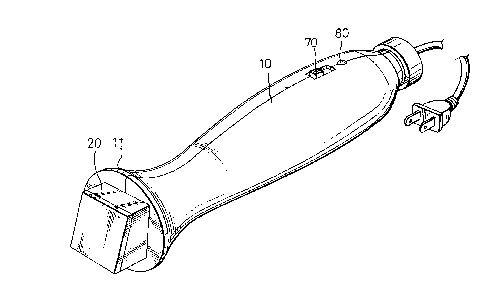Some of the information on this Web page has been provided by external sources. The Government of Canada is not responsible for the accuracy, reliability or currency of the information supplied by external sources. Users wishing to rely upon this information should consult directly with the source of the information. Content provided by external sources is not subject to official languages, privacy and accessibility requirements.
Any discrepancies in the text and image of the Claims and Abstract are due to differing posting times. Text of the Claims and Abstract are posted:
| (12) Patent: | (11) CA 2200035 |
|---|---|
| (54) English Title: | ELECTRIC HEAT PEN FOR GOLD-BLOCKING AND HEAT SEALING PURPOSES |
| (54) French Title: | CRAYON CHAUFFANT POUR ESTAMPAGE A L'OR ET SOUDAGE THERMIQUE |
| Status: | Expired and beyond the Period of Reversal |
| (51) International Patent Classification (IPC): |
|
|---|---|
| (72) Inventors : |
|
| (73) Owners : |
|
| (71) Applicants : |
|
| (74) Agent: | SMART & BIGGAR LP |
| (74) Associate agent: | |
| (45) Issued: | 2000-05-30 |
| (22) Filed Date: | 1997-03-14 |
| (41) Open to Public Inspection: | 1998-09-14 |
| Examination requested: | 1997-03-14 |
| Availability of licence: | N/A |
| Dedicated to the Public: | N/A |
| (25) Language of filing: | English |
| Patent Cooperation Treaty (PCT): | No |
|---|
| (30) Application Priority Data: | None |
|---|
An electric heat pen including a pen base adapted for
the holding of the hand, a pen head fixedly mounted on one
end of the pen base and holding a hot plate on the outside,
two plate conductors and an electric heating element between
the plate conductors on the inside, and a switch controlled
to connect electric power supply to the electric heating
element through the plate conductors, causing the electric
heating element to produce heat for heating said hot plate
for golf-blocking or heat sealing.
Crayon chauffant électrique comprenant une base pour le crayon adaptée à la prise de la main, une tête fixée à une extrémité de la base et retenant une plaque chauffante à l'extérieur, deux conducteurs de plaque et un élément chauffant électrique situé entre les conducteurs de plaque à l'intérieur et un commutateur contrôlé pour raccorder l'alimentation d'énergie électrique à l'élément chauffant électrique par les conducteurs de plaque, permettant à l'élément chauffant électrique de produire de la chaleur pour chauffer la plaque chauffante pour un estampage à l'or ou un soudage thermique.
Note: Claims are shown in the official language in which they were submitted.
Note: Descriptions are shown in the official language in which they were submitted.

2024-08-01:As part of the Next Generation Patents (NGP) transition, the Canadian Patents Database (CPD) now contains a more detailed Event History, which replicates the Event Log of our new back-office solution.
Please note that "Inactive:" events refers to events no longer in use in our new back-office solution.
For a clearer understanding of the status of the application/patent presented on this page, the site Disclaimer , as well as the definitions for Patent , Event History , Maintenance Fee and Payment History should be consulted.
| Description | Date |
|---|---|
| Inactive: IPC from MCD | 2006-03-12 |
| Inactive: IPC from MCD | 2006-03-12 |
| Inactive: IPC from MCD | 2006-03-12 |
| Inactive: IPC from MCD | 2006-03-12 |
| Time Limit for Reversal Expired | 2002-03-14 |
| Letter Sent | 2001-03-14 |
| Grant by Issuance | 2000-05-30 |
| Inactive: Cover page published | 2000-05-29 |
| Pre-grant | 2000-03-07 |
| Inactive: Final fee received | 2000-03-07 |
| Inactive: Received pages at allowance | 2000-02-22 |
| Letter Sent | 2000-01-26 |
| Notice of Allowance is Issued | 2000-01-26 |
| Notice of Allowance is Issued | 2000-01-26 |
| Inactive: Approved for allowance (AFA) | 2000-01-11 |
| Application Published (Open to Public Inspection) | 1998-09-14 |
| Inactive: First IPC assigned | 1997-07-21 |
| Inactive: IPC assigned | 1997-07-21 |
| Inactive: IPC assigned | 1997-07-21 |
| Request for Examination Requirements Determined Compliant | 1997-03-14 |
| All Requirements for Examination Determined Compliant | 1997-03-14 |
There is no abandonment history.
The last payment was received on 2000-02-15
Note : If the full payment has not been received on or before the date indicated, a further fee may be required which may be one of the following
Patent fees are adjusted on the 1st of January every year. The amounts above are the current amounts if received by December 31 of the current year.
Please refer to the CIPO
Patent Fees
web page to see all current fee amounts.
| Fee Type | Anniversary Year | Due Date | Paid Date |
|---|---|---|---|
| Request for examination - small | 1997-03-14 | ||
| Application fee - small | 1997-03-14 | ||
| MF (application, 2nd anniv.) - small | 02 | 1999-03-15 | 1998-11-27 |
| MF (application, 3rd anniv.) - small | 03 | 2000-03-14 | 2000-02-15 |
| Final fee - small | 2000-03-07 |
Note: Records showing the ownership history in alphabetical order.
| Current Owners on Record |
|---|
| AMMY CHOU |
| Past Owners on Record |
|---|
| None |